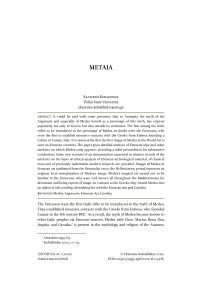Metaia
Автор: Ekaterine Kobakhidze
Журнал: Schole. Философское антиковедение и классическая традиция @classics-nsu-schole
Рубрика: Статьи
Статья в выпуске: 1 т.16, 2022 года.
Бесплатный доступ
It could be said with some precision, that in Antiquity the myth of the Argonauts and especially of Medea herself as a personage of this myth, has enjoyed popularity not only in Greece but also outside its territories. The first among the Italic tribes to be introduced to the personage of Medea no doubt were the Etruscans, who were the first to establish intensive contacts with the Greeks from Euboea founding a colony in Cumae, Italy. It is noteworthy that the first image of Medea in the World Art is seen on Etruscan ceramics. The paper gives detailed analyses of Etruscan olpe and other artefacts on which Medea early appears, providing a solid precondition for substantive conclusions. Some new versions of an interpretation expressed in relation to each of the artefacts on the basis of critical analysis of Etruscan archeological material, of classical texts and of previously undertaken modern research, are provided. Images of Medea in Etruscan art confirmed from the Orientalist era to the Hellenization period represent an original, local interpretation of Medea's image. Medea's magical art turned out to be familiar to the Etruscans, who were well known all throughout the Mediterranean for divination and being experts of magic. In contrast to the Greeks, they turned Medea into an object of cult worship, identifying her with the Etruscan sun god Cavatha.
Medea, Argonauts, Etruscan Art, Cavatha
Короткий адрес: https://sciup.org/147237622
IDR: 147237622 | DOI: 10.25205/1995-4328-2022-16-1-54-87
Текст научной статьи Metaia
Latins, Marsians, and Etruscans.3 Medea is encountered in genealogical myths, the most archaic mythological narratives of the Apennine Peninsula.
Information regarding the Etruscans’ understanding of Medea is derived primarily from different genres of Classical literature, that is to say, from secondary sources. Etruscan epigraphy and works of art constitute primary sources. It is noteworthy that the first image of Medea is found on Etruscan ceramics.
The study of the earliest appearance of Medea in Etruscan art is important in providing a complete account of the role of Medea not only in Etruscan but also in the Greco-Roman world.
The Olpe from Caere
Identifying the woman on the olpe from Caere, dating to 630 BCE, as Medea has no cause for doubt, because it is accompanied by the inscription Metaia , which represents an Etruscan transliteration of Medea’s name.4 In the image, Medea is surrounded by the Argonauts and Daedalus (Etr. Taitale ) . Perhaps there was a precondition for an interest in the myth of the Argonauts at Caere*; it was considered to be a place of the settlement of the Thessalian Pelasgians.5 The voyage of Jason, the Thessalian hero, was reflected in this myth.
Zoomorphic images are depicted on the upper frieze: a lion, panthers, and floral ornaments ( Figures 1 ).
A lion is placed in the center; panthers flank it. Each panther has a human foot protruding from of its mouth.6 On the lower frieze, the following scenes are depicted (from left to right) ( Figure 2, 3 ): two boxers with a sandal on one foot spar with each other; a young man rises out of a small, ritual (?) cauldron; and a woman wearing a long robe approaches a columnar wedge holding a staff in her left hand and raising aloft a magical staff in her right hand. The didaskalion Metaia is incised on her clothing. Next, six nude men follow in a line. The leader of the procession has his hand upraised as Medea. The men are holding a long, fabric-like item bearing the inscription kanna . A winged man, with his hands lifted high, brings the procession to an end. The name Taitale was inscribed between one of the wings and the body of the figure.
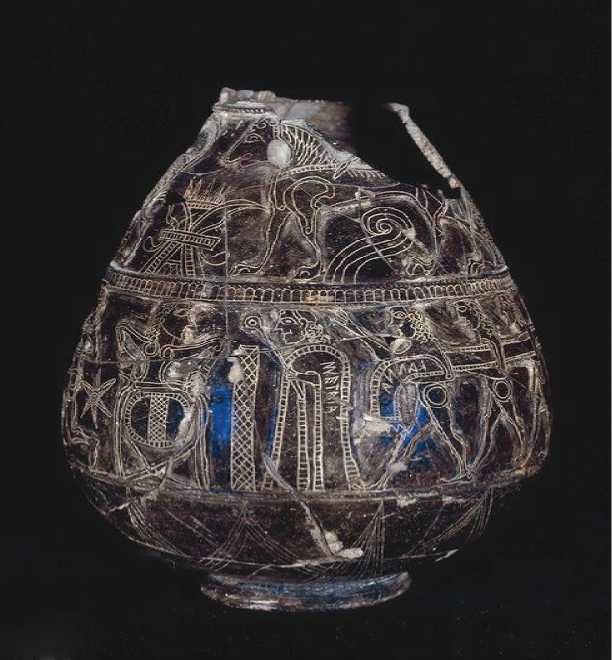
Figure i.
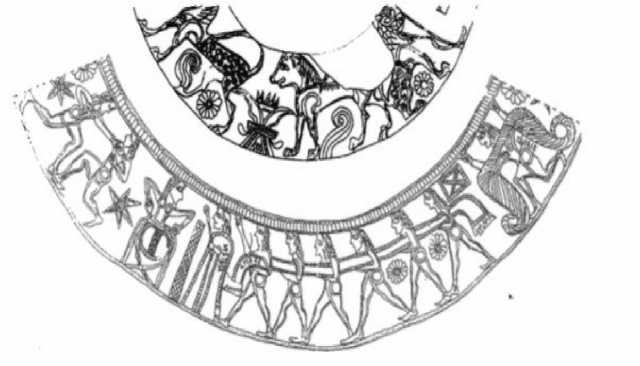
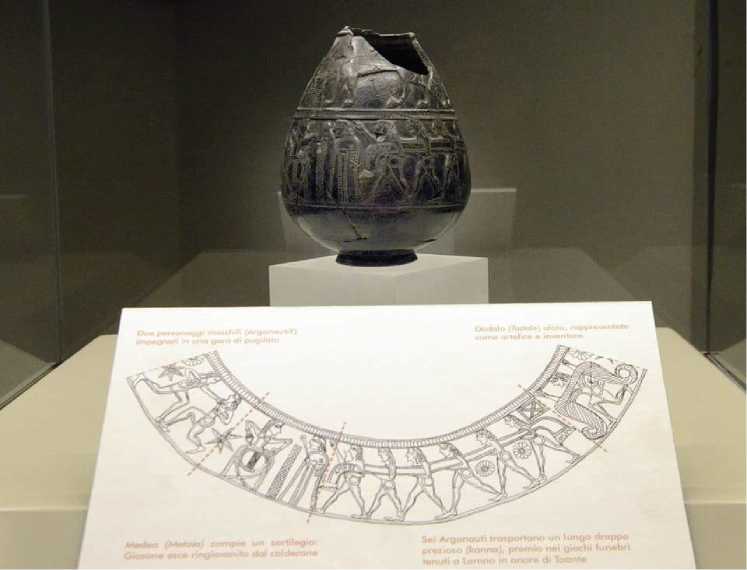
Figure 3
Although many investigations have been devoted to these images, questions remain, particularly that of the overarching mythological theme presented on bucchero: Which scene connected to Medea is pictured here? Who are the men in the procession? What do the boxers depict? And what is the connection to Daedalus? Is this a single episode or a cycle of episodes?
7.7. The young man coming up out of the three-legged cauldron andMetaia
Most scholars think that the scene where Medea rejuvenates through sorcery must be shown here, whereas the young man coming up out of the cauldron might be Aeson, Pelias, or Jason, who was prepared by Medea for Aedtes’ difficult tasks.7 It is possible that all of them are conflated here, so that Medea's depiction as a sorceress might be generalized in this way.8 Nino Lortkipanidze justifiably notes that “flatly identifying the pictured young man as someone becomes more difficult due to the fact that all the literary sources connected to the miracle of rejuvenation by Medea belong to a period considerably later than 630 BCE.”9
The earliest of these literary sources regarding Jason's rejuvenation by Medea is found in Simonides10, while Aeson’s rejuvenation appears considerably later in Ovid11. The scene of Aeson’s rejuvenation never appeared in art. In the classical age, rejuvenation generally implies a transformation from an old person to a young one, or from a young man to a teenager or child.12
Understanding the young man emerging from the cauldron on the Etruscan olpe to be Pelias is impossible; according to myth, Pelias was never truly rejuvenated. His body was boiled in a cauldron and he passed away as an old man. In order to see which version of the theme is represented more frequently on other Etruscan artifacts, we can examine two 4th century BCE Etruscan mirrors of the Hellenistic period (Figure 4a, 4b)
The figures of three women, standing, and a man who is seated, are accompanied by the inscriptions. Metvia , Menrva , Rescial , and Heasun appear on 14a, which was found in Talamone in 187813. Metvia14 is a transliteration of Medea; the figure holds a drinking bowl in her right hand and brings it to the lips of an al-most-unconscious Heasun (Jason). Menrva , the Etruscan counterpart of Athena, is easily identifiable via her aegis. Metvia tries to grasp .Jason’s neck with her right hand while holding an oinochoe in her left in which a magical liquid has supposedly been poured. A bird flies close to her hand.
Similarly, an oinochoe is held by Menerva on the pedimental sculpture of the 5th century BCE Temple A at Pyrgi. The sculpture depicts an episode from the play, Seven Against Thebes . ' 5 Menrva may be attempting to bestow immortality upon Tydeus ( Figure 5 ).16
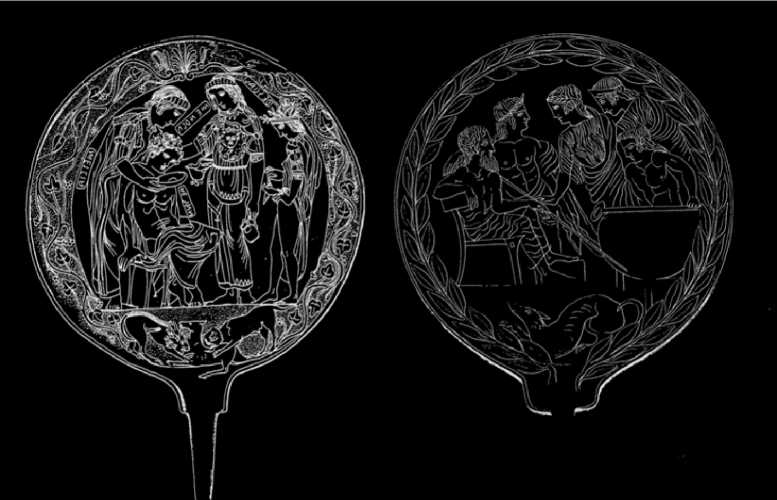
Figure 4. a. b.
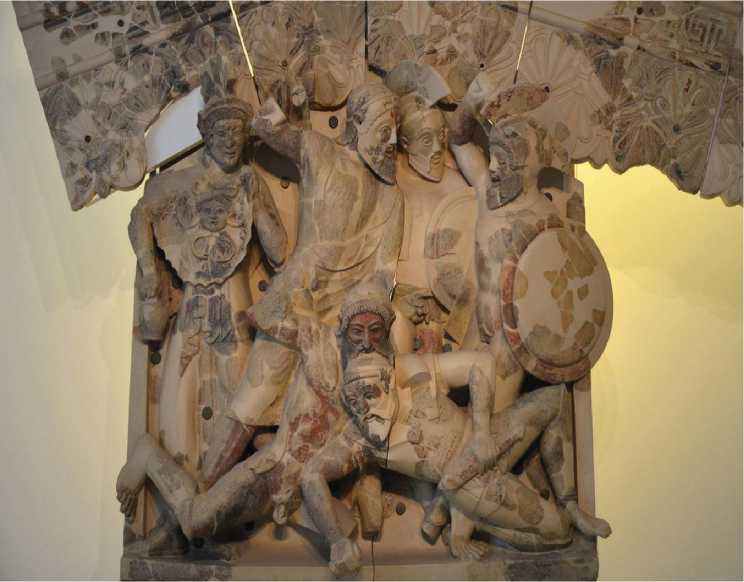
Figure 5.
The figure labelled Rescial may be one of the Lasas (Etruscan deities, mainly female), represented on several Etruscan mirrors.17 In the opinion of some researchers, this scene represents the Colchian episode of the Argonaut myth, in which Medea gives Jason a magical liquid to drink in order to successfully complete Aect.es' difficult tasks (Figure 4a).18 Unfortunately, the other mirror was not inscribed (Figure 4b).19 The scene depicts a man climbing out of a cauldron. To the left is an elderly man and a young man, who sit on a bench; two women stand nearby. According to Jennifer Neils, the scene represents Jason's rejuvenation in lolcos, attended by Pelias, his son Akastos, Medea, and one of Pelias’ daughters, although it is possible that two of Pelias’ daughters are present instead of Medea.20
The episode on this mirror is analogous to scenes pictured on 5th century Attic lekythoi in which a young man also appears in a cauldron. One such scene on an Attic lekythos discovered in Etruria, which initially was connected to the rejuvenation of Jason’s father Aeson,21 serves as an example ( Figure 6 ).
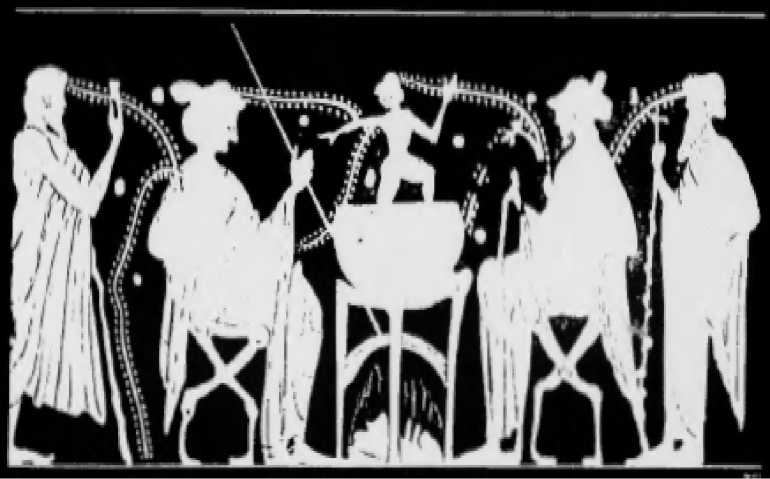
Figure 6.
This episode is described in Ovid, but has not been confirmed on any work of art.22 Later, it was interpreted as the episode of Jason's rejuvenation by Medea in
Ekaterine Kobakhidze /ЕХОЛН Vol. 16. i (2022) 61 lolcos. This interpretation is supported by some artifacts regarding a red figure hydria discovered in Etruria. 23 A white-haired Jason stands by a three-legged cauldron, watching Medea boil a sheep ( Figure 7 ).
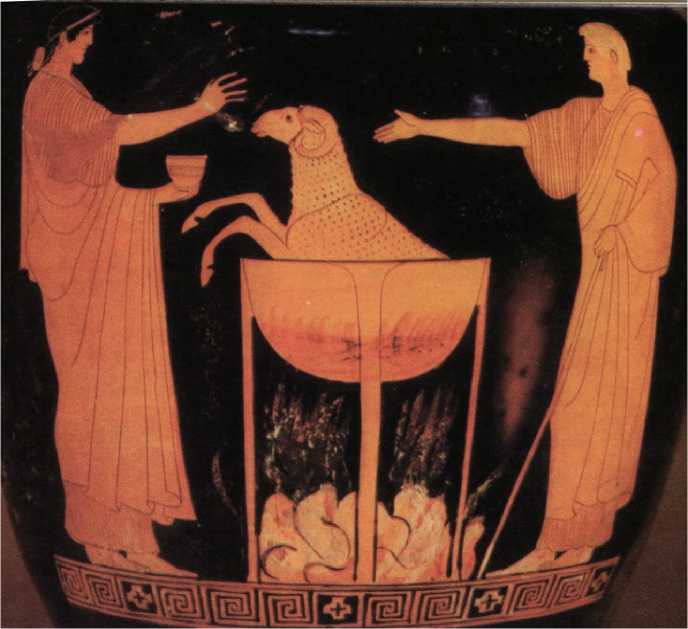
Figure 7.
Since an image of Aeson's rejuvenation has yet to be found, it is impossible for Aeson to be shown in this representation; the young man rising up out of the cauldron on the Etruscan olpe must be Jason. Why is Jason’s name not incised on the Cerveteri olpe? How can we identify him? Jennifer Neils notes that Jason generally does not have a distinguishing mark differentiating him. He is frequently shown naked or with a traveler’s cloak and cap; he is encountered even less frequently with a single sandal.24
In regard to the reason as to why the name of the main character from the Argonaut myth is not shown, while those of Medea and Daedalus are, I propose that the young man pictured on the olpe must be Jason, despite the lack of in- scription, and accordingly, the central scene reflected on the Etruscan lekythos must show Jason’s rejuvenation by Medea in lolcos.
In this respect, the depiction of an Etruscan ritual on an Etruscan mirror from 275-250 BCE is relevant.25 Three children with the names Maris Isminthians , Maris Husrnana , and Maris Haina follow an initiation ritual by submerging themselves into a deep vessel filled with liquid ( Figure 8 ).26
Figure 8.
It is notable that the Etruscan god Maris, having three epithets embodying the god’s various ages here, is shown on yet another bronze mirror from Chiusi (325300 BC- Berlin, Berlin, Staats Museum Antikensammlung) where he is participating in the same initiation ritual by submerging himself in a liquid.27 Maris, who was a patron god of fertility in archaic Etruscan conceptions, is a symbol of renewal and rebirth in his Ausonian variant (Mares), having been shown as a centaur. He died and rose from the dead three times ( Figure 9 a ).28
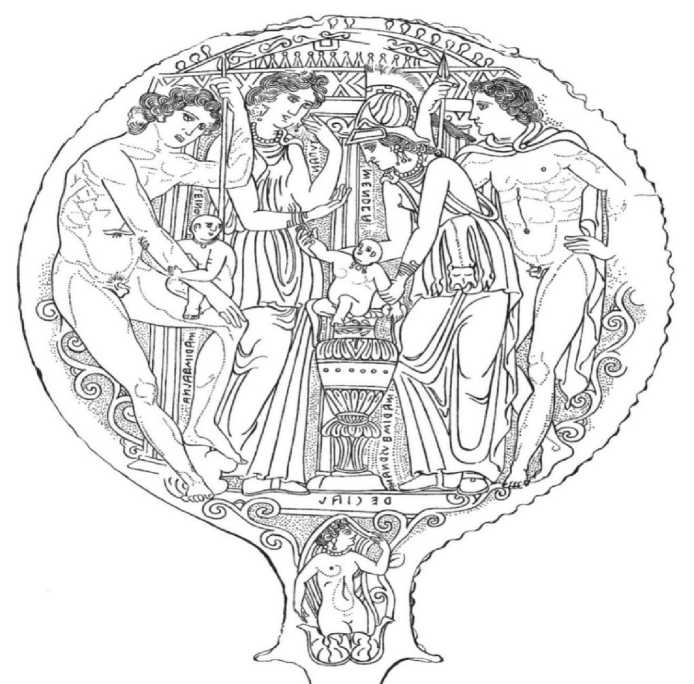
Figure 9. a
The same ritual is seen on an Etrusco-Latin cista from Palestrina on which Menerva stands in a cauldron of boiling liquid along with the armed Maris. Menerva has one hand wrapped around Maris’ leg, whereas she holds a slender stick or spike up to his face or nose. Cerberus has been shown by Maris’ head, and an image of a winged woman flies close to Menerva ( Figure 9 b ).
It is noteworthy that despite the myth connected to the Argonauts on the Etruscan olpe, the scene is adorned with particularly Etruscan features: Medea is wearing Etruscan attire,29 she is holding a staff, and there is a small cauldron characteristic of Etruscan rituals in which Jason undergoes rejuvenation, all similar to other Etruscan works of this period.
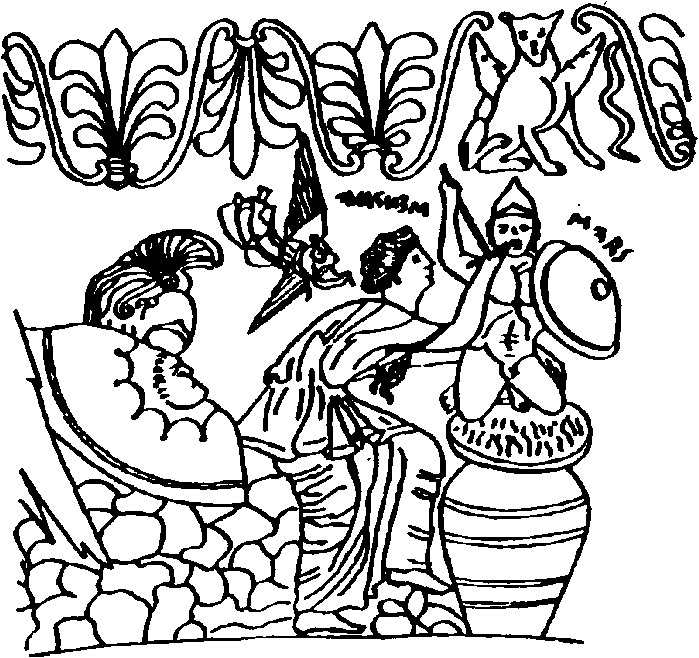
Figure gb
-
1.2. The six men and каппа
Maria Rizzo identifies the six men as the Argonauts, but the oblong object they hold is not the Golden Fleece or the Argo, as we might have expected according to the myth. Instead, it is identified as the fabric mentioned in Pindar’s fourth Pythian ode, which the Argonauts had received as a winning sign in a competition held on the island of Lemnos.30
Erica Simon agrees with Rizzo that the Lemnian episode of the Argonaut myth is shown here, but she thinks that the Argonauts do not appear here; instead, they are the Dactyls, patrons of the art of finding iron and greatly honored on the island of Lemnos. The Dactyls therefore hold a door bolt.31 As demons of craftsmanship, the Dactyls are an ideal combination of Medea, who possessed magical abilities, and of Daedalus, a skilled artisan.
In my opinion, the men pictured on the Cerveteri olpe following along behind Medea in a line create a unified composition with Medea, and it is not possible to examine them independently from the figure of Medea. It is quite clear that Medea and the figure at the head of the procession are participating in the same ritual; the man’s front foot touches Medea's long robe. At the same time, if this scene is from the Lemnian episode of the Argonauts, Medea should not be here because this adventure befell the Argonauts before they sailed to Colchis.
The meaning of the word каппа could provide additional clarification of this topic. The word in this form appears in Etruscan texts only once. It is similar in form to сапа/капа, which is attested in other Etruscan inscriptions.32 As for the meaning of сапа/капа, as confirmed in a number of epigraphic works, it has the following ranges of possible meanings: “decoration”, “gift”, “statue”,“image”.33 каппа comes from * капа-па, where the - па suffix, that in Etruscan language forms the adjectives of possession and reference,34 is universally understood to mean “belonging” (here: “belonging to kana”- “belonging to the gift or to the offering”). Other interpretations of this word exist, according to which каппа must be read as каппа, perhaps connected to the Greek word zauvaz^, which itself is etymologically connected to дпппакп in Persian and Syriac, meaning “something made from fur”.35 In Burkert’s point of view, this word came into the Greek lexicon from Persian during the so-called Orientalizing period with the meaning of “a worsted wool cloak”.36 On the basis of the latter interpretation of the Etruscan word, one can justifiably connect the image on the olpe to the Lemnian episode: the Argonauts bring a woolen fabric37 which they have earned as a prize for winning in a competition on Lemnos. Schmidt38 believes that this word might be connected to the Greek word “xavvag” which is found in Aristophanes’ The Wasps and refers to a sacred rug made from willow branches or grapevines.39
According to Helmut Rix, kanna cannot be a local variant (with geminate n ) of Etruscan cana/kana , but is a different word, homonymous to cana/kana. 40 Rix does not agree with the attempt of Bellelli to connect kanna with the Greek “xavva” (reed)41 but supports another hypothesis of the same author42 on the meaning of kanna as “xavva^ig” (cannabis), thinking that kanna/canna means a material probably used like flax, to make sails (hence, one might suppose that Argonauts are holding the sail of Argo).43
The latter opinion offered by Rix seems to provide the most accurate etymology of the Etruscan word kanna , since it might be essentially closer to the context of the episode, creating on olpe some allusion of the ship Argo. This version is further supported by the fact that ship’s tackles were given as offerings at the Temple of Pyrgi and at Caere are also found.44 Accordingly, it really may have been placed in the corresponding box located between Daedalus and the sixth man.45
If kanna is really a sail of Argos, brought as a gift, then this could only happen at the end of the voyage, on lolkos.
Thus, in my opinion, the theme shown on the olpe reflects the scene of Jason’s rejuvenation by Medea in lolcos, which in comparison to the Lemnian interpretation, might have been attended by all the participants of this narrative - Medea, the Argonauts, and Jason.
-
1.3. The boxers
If we connect the scene depicted on the bucchero olpe to the island of Lemnos, then the boxers are the Argonauts participating in a contest, earning a prize later on as well. What about the reason of why the contestants are wearing only one sandal.
In one version, one of the contestants might be Jason himself, who, according to the myth, had lost a sandal in Pelias’ palace before his arrival,46 whereas in a second version, these are other Argonauts competing against each other for their other sandal.47 Neils notes that wearing a single sandal might have been significant for a young man during an initiation.48 De Grummond also interprets the scenes presented on the olpe as an initiation ritual, with the beginning of the ritual in the competition, followed by washing and receiving a garment as a gift.49
The Etruscan tradition of boxing scenes on ceramics is interesting. One artifact at the Dallas Art Museum is noteworthy in this respect; it depicts some boxers fighting each other for a prize shown on a second plane. The similarity of the poses between the boxers shown on this ceramic object and the boxers on the olpe from Cerveteri are striking. In both cases the boxers have one foot extended forward and placed on their opponent’s foot. One hand is bent and the other is brought forward. This vessel is dated to 750 BCE and can be considered as a prototype of the Cerveteri boxers ( Figure 10 ).
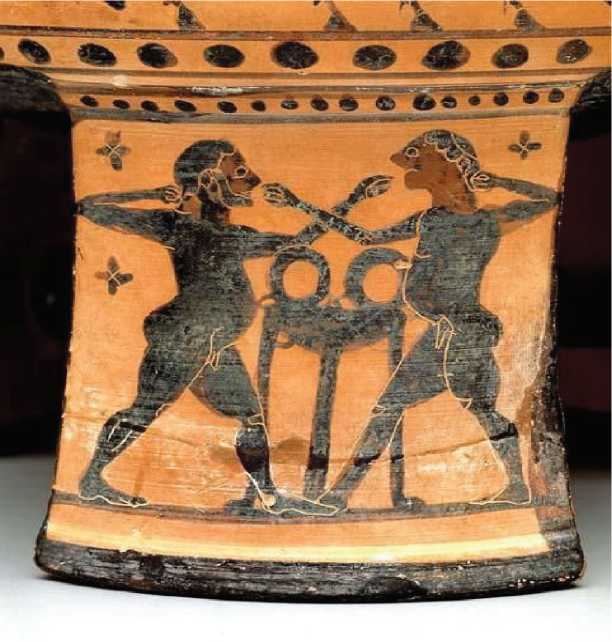
Figure 10
Despite the various interpretations of the theme shown on the Etruscan olpe , a majority of researchers agree that the boxers are the Argonauts. Supporters of the Lemnian interpretation consider this match to be a part of the Lemnian competition.50
In my opinion, the ritual of Jason’s rejuvenation has a sacral significance indicated by the images of the priestess, the three-legged cauldron, offering ( каппа ) and like all the rituals in Etruscan tradition, accompanied by sacral contests. The ritualistic nature of the athletic contests was clearly not foreign to other cultures, yet athletic fights in Etruscan tomb paintings, as a rule, were accompanied by images of priests, an idea foreign to the Greek world. Let us examine an image showing a wrestling match dated to 530 BCE from the Tomb of the Augurs at Tarquinia ( Figure 11 ). As is clearly seen, an augur holding a curved staff ( lituus ) appears behind the contestants and divines the future according to the flying birds. Along with this, some ritual cauldrons (three stacked on one another) stand between the wrestlers, indicating the sacral nature of the contest.
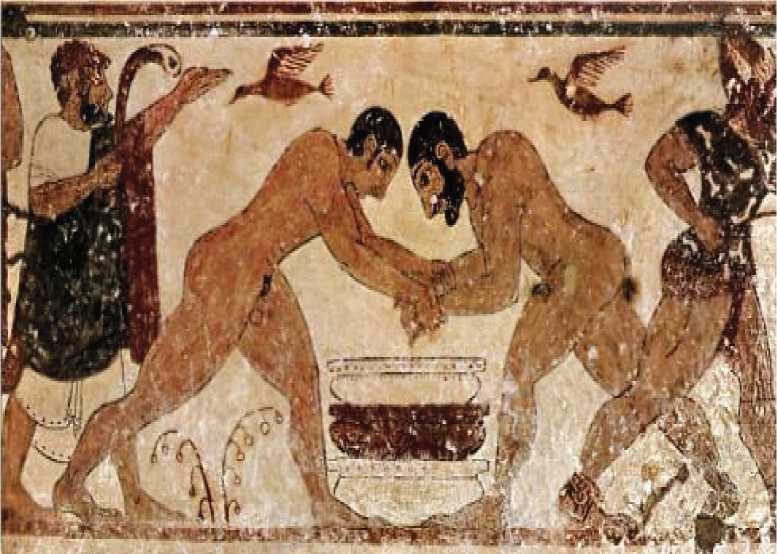
Figure 11
Thus, the scene on the Etruscan olpe must be examined as a single narrative presented in one act, which is relevant to the lolcos episode of the Argonaut myth. The central figure of this episode is Medea, who is rejuvenating Jason. This ritual is accompanied by a procession of men (Argonauts) behind Medea, the priestess, with a ritual gift and by athletic contests with the participation of the Argonauts. In my reading, the unified nature of the narrative is strengthened by archaeological data. The scenes shown on Etruscan ceramic of this period reflect only one specific episode from a Greek mythological narrative and a combination or alternation of a few episodes on it are only confirmed later on.51
Thus, this episode of the Argonaut myth, which the Etruscans borrowed from Greek colonists, underwent a transformation on Etruscan soil and became suited to the expressive forms and cultural reality of Etruscan society. Attired in Etruscan garments and holding an Etruscan staff (which is not naturally encountered in an analogous scene on Greek vases), Medea performs a ritual by following Etruscan customs. Boxers and participants who process toward the altar carrying a votive gift are involved in the ritual. The ritual reflects a man’s initiation, in which a contest, initiating in cauldron and a sacrifice are presented.
Indeed, it is difficult to find logic in the selection of an episode from Greek mythology to place on something made locally by the Etruscans. But in my opinion, this logic really exists, especially at the first stage of Greek-Etruscan relationships and until the so-called Hellenistic period in Etruscan art began. The following specific factors define the depiction of the narrative connected to the Argonauts on this Etruscan olpe :
-
I. Caere : Naval might was not the only reason for Caere's close relationship with the Greeks. Along with the city of Spina, Caere was traditionally considered to have been founded by the Pelasgians of Thessaly.52 Thus, specific preconditions existed for an interest in the Argonaut myth reflecting the distant voyage of Jason, a Thessalian hero, right here in Caere.
-
II. The sacral factor : This specific theme from the stories of the Argonauts was selected due to its sacral function. The Etruscans were distinguished all throughout the Mediterranean for their knowledge in various arts of divination and for their religiosity.
-
III. The lolcos episode of the Argonaut myth was interesting for the Etruscans precisely within the context of a deceased person's burial , for it reflected a process of rejuvenation, a renewal of life stirring hope for the deceased to be reborn.
-
IV. An initiation ritual connected to renewal and rejuvenation existed in Etruscan cult worship, as was mentioned above.
The analysis of Etruscan ceramics from the Archaic period reveals that the Etruscans aspired towards naturalism when conveying Greek myths and they maintained some independence in the context of assimilating the culture of other peoples.53
Szilagyi's hypothesis is also worthy of note here, as he studied themes shown on Etrusco-Corinthian vases from 630-500 BCE. Despite the existence of Greek mythological figures on Etruscan ceramics, he concluded that they had an Etruscan essence. Many things as such were discovered in these works where the theme has not been identified and it is clearly based on an Etruscan context. He names one of the objects at Villa Giulia as an example of this, which is dated to the years 630-580 BCE, where some themes completely unknown to Greek mythology are depicted.54
The episode shown on the Etruscan olpe has been interpreted through local traditions which implied the placement of the ritual within a so-called Etruscan context and its depiction through attributes and forms (the boxer scene, the ritual of dedicating каппа , Medea depicted with a staff) characteristic of Etruscan cult worship and rituals.
-
1. 4. Daedalus
Clearly, it’s impossible to make a conclusion without an analysis of Daedalus’ figure, because the presence of Daedalus surrounded by Medea and the Argonauts remains a problem for the researchers. Currently, not one theme from Greek mythology or literature has been confirmed to connect Daedalus with the characters of the Argonaut cycle.
Those supporting the identification of the scene on the olpe as the Lemnos episode of the Argonaut myth explain Daedalus' appearance beside Medea and the Argonauts (the Dactyls) in the following manner: as a craftsman and inventor bestowed with a special talent, having been transformed into an epithet of craftsmanship. 55 Daedalus is “ideally” connected to the island of Lemnos. Ac- cording to Homer56, Hephaestus' blacksmith shop was located in the crater of an active volcano on Lemnos, where the capital was Hephaestia57, representing a place in the world renowned for the discovery of metal and metallurgy. In the same respect, the Colchis “of plentiful gold” stirred up some interest, with the Etruscans being intrigued by this as well, as they, too, were distinguished for finding and working with metal. Lemnos and the communities of Colchis were symbolically connected to each other.58 Accordingly, it is possible for Daedalus and the Argonauts (the Dactyls) to be associated together within this context. Lortkipanidze names the extant ancient contacts between Etruria and the island of Lemnos as some of the motives and additional arguments for the Lemnos episode of the Argonaut myth on this vessel. Particularly, some information regarding the resettlement59 of the Tyrsenians (Etruscans) and the dwelling60 of Pelasgians and Tyrsenians on Lemnos are corroborated by Herodotus. This is confirmed by archaeological data, particularly by a stela from Lemnos dating to the 6th century BC inscribed in a linguistic cognate to Etruscan which indicates an organic connection between these two geographic centers.61
It is clear no one denies the close connection between Etruscan and the language of the Lemnos stela, which is clearly reflected in very recent research by de Simone, Hergon, and Maltzham62, yet it also must be taken into account that, aside from this specific case, no work of Etruscan art was considered to be the probable depiction of some mythological or historical fact connected to Lemnos.
At the same time, it must be noted that apart from Caere’s mythological relation to the Thessalians, the city of Tarquinia had intimate connections with another area relevant to the Argonaut myth, Corinth, which is confirmed in Antique literature. A myth narrated by Pausanias in Description, of Greece states that Athena's temple, located in Corinth and called Salpinga, had been founded by He-geleus, Tyrsenos’ son (this is the Tyrsenos, who according to Herodotus, led people from Lydia who were later given the king’s name as an ethnonym) and
Heracles’ grandson.63 The settlement of the Corinthian Demaratus in Etruria attests the extant bilateral connections between Etruria and Corinth.64
Let us return to the Etruscan olpe and examine the theme of Daedalus, Medea, and the Argonauts with the assumption that in all, the Lemnos episode is not pictured, but instead it is the one at lolcos, specifically the scene of Jason's rejuvenation by Medea in which the Argonauts participate. How is it possible to include Daedalus in this context?
Before this topic is examined directly, a brief mythological digression points out certain parallels between Daedalus and Medea. Having never ended up in one mythological narrative, it is notable that certain points of contact can be found for Medea and Daedalus, despite them being distinguished from ordinary mortals through special abilities: magic and craftsmanship:
-
i. It is true that having a discussion about a precise chronology in a myth is impossible, but Medea and Daedalus are “contemporary” characters - Theseus, the one who defeats the Minotaur imprisoned in the labyrinth built by Daedalus, is Medea's step-child.
-
2. Daedalus is also connected to a solar cult like Medea (Medea, as the grandaughter of Helios; Daedalus as a servant of Pasiphae, Medea's aunt and Helios' daughter, a craftsman having flown towards the sun and lost his only son due to the sun's power);
-
3. Medea and Daedalus have each committed the murder of a close relative in their homeland;
-
4. Like Medea, Daedalus also runs away from his homeland and then leaves his new homeland, where he loses his child (children). Both of them run to safety by flying away.
-
5. Medea defeats Talos, Daedalus' creation, with her sorcery.
-
6. And finally, an episode of great interest to us - the murder of Pelias carried out by Medea through Pelias' daughters, with the body of the king lolcos being boiled in a bubbling cauldron (in general, a person's rejuvenation or them being brought to life by being boiled in a cauldron is not foreign to other epochs and cultures65). This manifests a certain likeness to Daedalus' adventure. Although being of a later character, it is quite interesting - having escaped from Minos, Daedalus seeks refuge in Sicilia with Cocalus, the king of Kamikos. When
Minos comes looking for Daedalus, Cocalus makes him agree to bathe in the bathhouse. Here he is killed by Cocalus' daughters, or according to a second version, Daedalus throws him into the boiling water and kills him.66
I return to these parallels in my conclusion. Before presenting them, it seems necessary to examine Daedalus in the context of Etruscan art and mythology. It is universally recognized that the term “Taitale” on the olpe is the Greek Daedalus. Images of Daedalus appear elsewhere in Etruscan art with precisely this form of the name (with some minor alterations - Tattle ), such as on a Carnelian scarab beetle ( Figure 12 ).67 It is dated to 450-400 BCE and shows Daedalus ( Tattle ) bobbing on top of the sea.
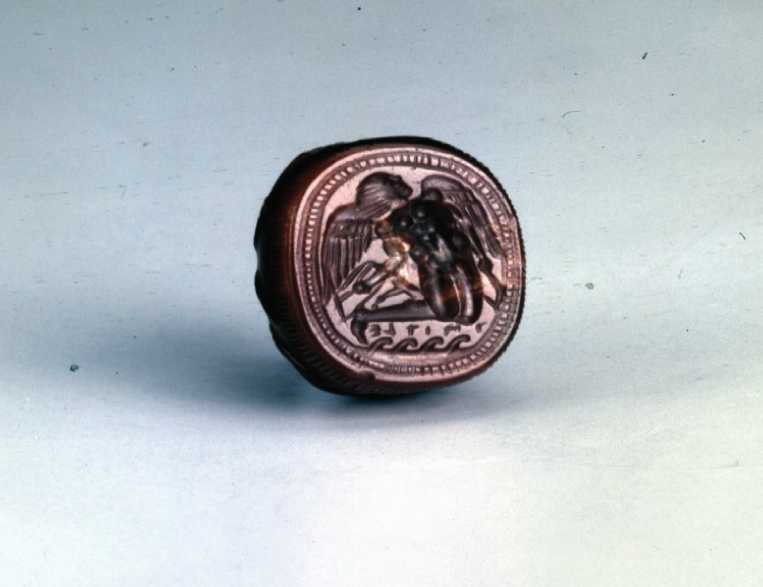
Figure 12
It is also on a 5th century BC golden bulla68, where Icarus (Vtkare) is depicted together with Daedalus. This last inscription where the Greek digamma is reflected indicates that the story of Daedalus and Icarus had been known in Etru- ria from a much earlier time, and it might have been borrowed from a Dorian source - either Corinth or Crete (Figure 13).69
Both these Hellenistic period works are comparatively later than the Cerveteri olpe. Along with this, as on the scarab, the episode of Daedalus' well-known adventure from Greek mythology is shown on the bulla, which cannot be said for Daedalus' unknown narrative shown on the olpe. Yet he is pictured here with wings like on the seal and the scarab.
It must be noted that there is an idea regarding the differentiation of functions of Daedalus' images during the sixth century in Etruscan art. Specifically, Daedalus, according to Prayon, could be perceived as a mythological character in the first half of the 7^-6* century BC, and as a so-called “local” craftsman and mythic hero in the second half of the 6th century and the 5th century BC.70 Accordingly, based on the date of the olpe, Daedalus must be understood as a mythological character, possibly as a demonic power in comparison to the Daedalus pictured on other Etruscan works, where he comes across as a craftsman or mythic hero. What must this demonic character depict in this specific context?
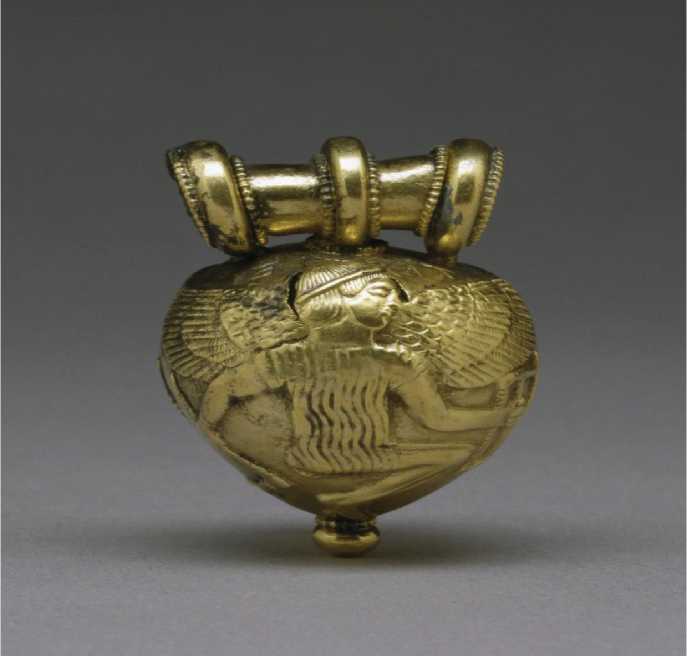
Figure 13
In relation to Greek myths, the work of Etruscan potters and painters, as a rule, was characterized by thematic transformation and variation, revealing their artistic freedom and at the same time, a desire for Greek myths to fit into an Etruscan cultural reality.71
If the scene depicted on the Etruscan olpe is viewed within this context, where, as was mentioned before, a ritual of Etruscan rejuvenation or rebirth can be deciphered beyond the lolcos episode of Jason's rejuvenation by Medea, and in which a priestess and participants of various cult acts of a ritual initiation -that of a contest as well as a sacrifice - are included, it will be possible to explain Daedalus' appearance within this context as well.
If we again return to the Etruscan mirror on which three figures of Mars are shown and the scene of the Etruscan rejuvenation is depicted, a few gods are presented here, including Menrva and Turms. Maris Isminthians sits on Turms'
arm, a god corresponding to Hermes Psychopompos.72 Is the winged being corresponding to Teitale among them or not?
A winged being in Etruscan art of the Orientalizing period is only equivalent to a God and Demon. Winged beings generally reflect movement between the realms, whereas in tomb art - a movement from this world to the next, from death to life.73 Here, Daedalus must be examined as a winged, demonic power attending the scene of rejuvenation and rebirth. Which god can attend such a ritual?
Providing an answer to this complex question significantly digresses from the theme of the paper. At a glance, this scene, reflecting a rejuvenation ritual and implying rebirth, might have been attended by a pscyhopompos god, including Turms or many other gods connected to the underworld, of which many are represented in the Etruscan pantheon. Yet I think two factors must be given more consideration:
-
I. Local (in this case Caere) cults and their functions;
-
II. Represented images with the same expressive forms during the same chronological period.
Which gods are depicted with wings among the honored gods in 7th century Caere and which of them can be connected to the renewal of life and rebirth?
Caere and its port Pyrgi were known for temples of many gods. Each Etruscan city had a so-called prominent god which was especially honored along with the common Etruscan gods. Six temples have been identified in Caere, with only two of them having been studied under controlled archaeological investigation. One is a temple dedicated to either Leucothea (Pseudo Aristotle)74 or Ilithyia (Strabo)75 and is dated to the 5th century BC76. There is also the 6th-century temple of Uni. According to tradition, the temple of Leucothea at Caere had been founded by Pelasgians from Thessaly.77
Leucothea and Ilithyia (Eileithyia) have been identified with the Etruscan goddess Thesan by researchers.78 Thesan the dawn goddess is an ancient winged goddess remembered in the form of Thes/ Thesan on the Liber Linteus, ( Etruscan linen book of 3rd century BC, most probably the ritual calendar) She was especially honored in Caere and Pyrgi.79 It is noteworthy that she was simultaneously the goddess of divination, childbirth, and the generation of life.80 Her name Thesathei is supposedly commemorated in an inscription on a 7lh-century bucchero amphora from Chiusi and on a oinochoe from Tragliatella.81 It is noteworthy that she is encountered with the sun god Usil on the Liber Linteus Zagrabiensis mummy wrappings (TLE 1)82, as well as on many images.83 In regard to images of Thesan during the Orientalizing period, a few works along this line are interesting, where Thesan is presented while flying. Her image on an acroterion within Leucothea's temple at Caere is also informative in this regard. Thesan is taking away a young man (adolescent?) in her arms while flying (Figure 14).
An image of Thesan on a bronze mirror from Vulci dating to 570 BC shows the goddess again taking up a young man in her arms and is flying away quickly. According to interpretations of the image, here the myth of Eos and Cephalus is depicted. In my opinion, the mirror represents a Hellenic attempt at interpreting the Etruscan theme shown on the acroterion. ( Figure 15).
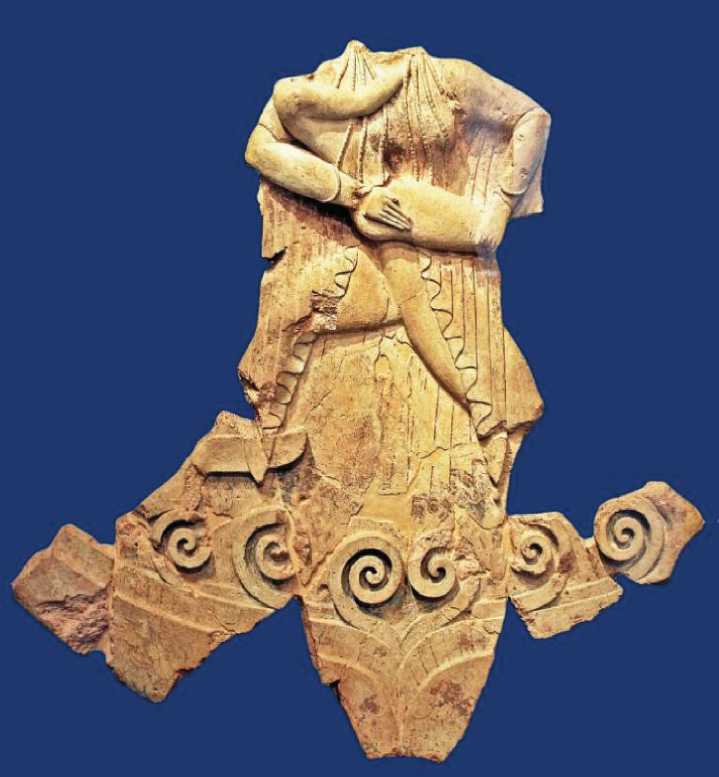
Figure 14
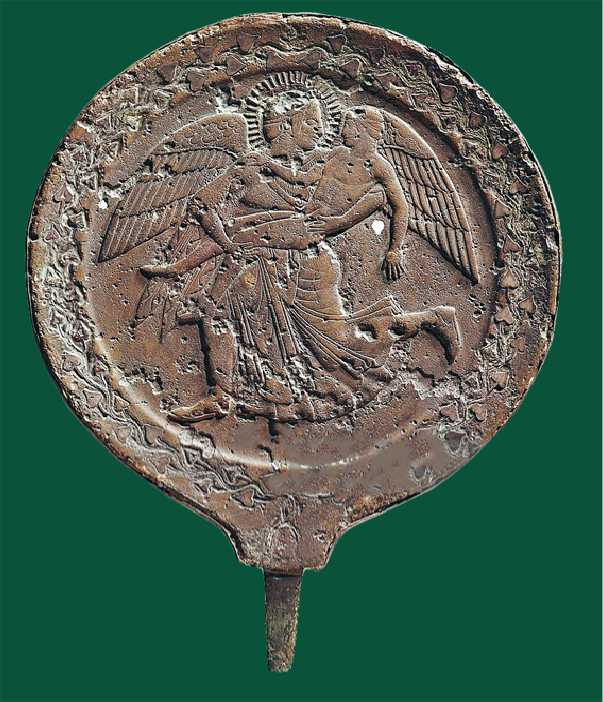
Figure 15
It is possible to surmise that the on olpe Etruscan Thesan is meant under Taitle, which as a specially honored goddess and a patron of rejuvenation in Caere and Pyrgi, attends this initiation ritual and is perhaps trying to snatch up the rejuvenated young man. But the figure depicted on the Etruscan olpe is not a woman, attested by its connection to Daedalus and its nudity, which would not be appropriate for a goddess in the Etruscan Orientalizing period. Some other male solar god might be here, encountered in Thesan's retinue. This might be the sun god Usil,84 who was also specially honored at the temple in Pyrgi ( Figure i6 ).In this respect, images of Usil from the Orientalizing period at the A Temple in Pyrgi are especially interesting, showing great similarity to the figure of Taitale depicted on the olpe.
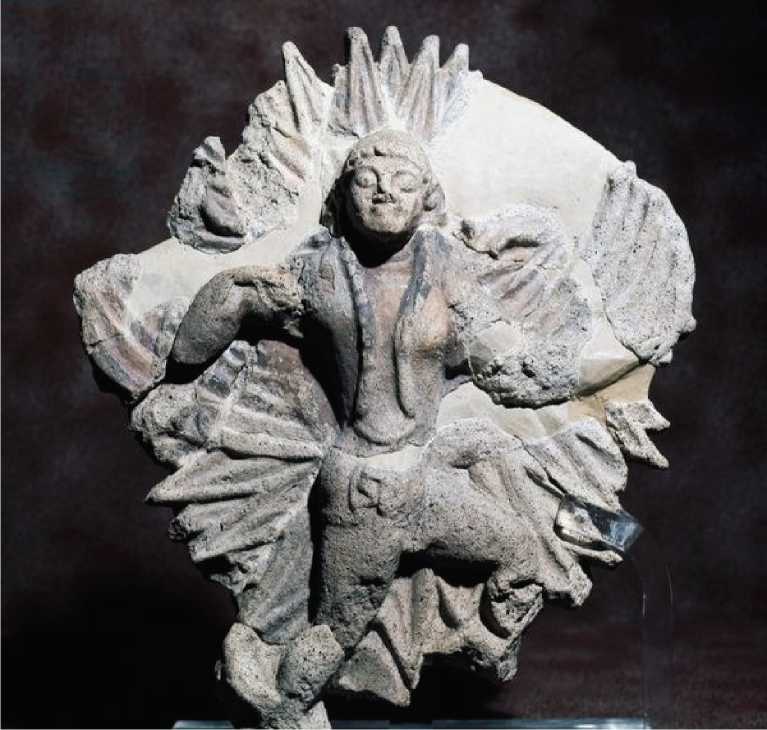
Figure 16
Very similar is the image of the God of Sun presented on the amphora of the Tolfa-Malers,85 ( Figure 17) and a bronze image of Usil (?) supposedly from Vulci dating to approximately 490 BC.86 ( Figure 18)
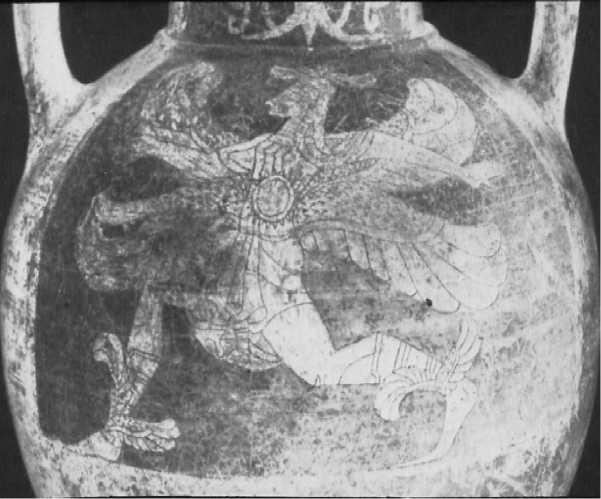
Figure 17
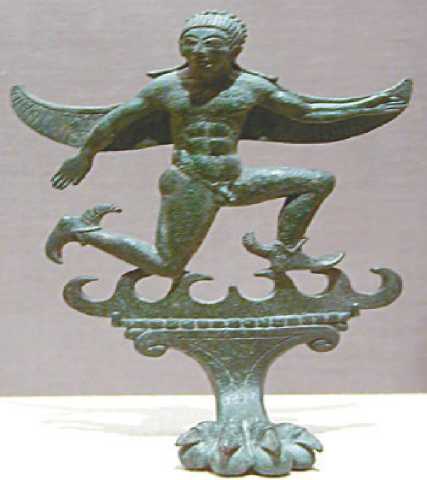
Figure 18
Thus in my opinion, it is the winged Etruscan solar god Usil/Catha “hiden” beyond Teitale pictured on the Etruscan olpe from Caere . He had a local cult in Caere (Catha/ Cavatha is mentioned seventeen times in vascular inscriptions from Pyrgi87) and images of him were typologically connected to winged images of Daedalus.
This connection was supposedly not based only on an iconographic similarity, but instead on a realization that the the winged Daedalus was in a certain relationship with the sun. It is possible to examine Medea as well in the same context as the granddaughter of Helios. Medea, who was connected to the Etruscan god Cavatha (Suri or Sur)88 the daughter of the sun Catha89, was naturally included in this narrative.
Conclusion
The rejuvenation of Jason by Medea is pictured on the Etruscan olpe, with an Etruscan ritual of rejuvenation and rebirth being interpreted behind it (this ritual is known from images and antique sources). This ritual was connected to solar cults, which were characteristic of many religions and the cult worship of Egypt and the East. The sun, being born anew every dawn, was perceived as a symbol of rejuvenation and rebirth.90 Catha was considered relevant in the underworld that was attested by inscriptions from a funerary context referring to her by name, or as daughter, and by her inclusion on the leaden tablet from Magliano”.91
The ritual of rejuvenation in the context of the Etruscan tomb stirred up hope for the deceased's rebirth and immortality. The Etruscans' longing for cultural relationships with the Hellenic world is reflected by the perception of characters of the Argonaut myth as participants of the ritual, including Medea and Daedalus, a hero of a popular mythological narrative and a possessor of demonic power. The allusion of Argo created by “kanna”- sail of the ship, carried by the Argonauts at the same time is the part of Etruscan ritual as an offering to the Gods, worshiped at Caere, as it is documented by archeological materials from Temple of Pyrgi. Among these gods were also Cavatha and Usils, which are presented here “beyond” Metaia and Taitale. At the same time, it answered a modal tendency of the Etruscan elite's infatuation with “foreign” culture. Images of Medea in Etruscan art confirmed from the Orientalizing era to the Hellenistic period represent an original, local interpretation of Medea's image. Etruscan culture, in this way serving as a mediator between the Greek and Italic worlds, popularized Medea and the myths connected to her on the Appenine Peninsula. Medea's magical abilities were familiar to the Etruscans, who were well known all throughout the Mediterranean for their skills in divination and magic. In contrast to the Greeks, they turned Medea into an object of cult worship, identifying her with the Etruscan sun god Cavatha. She penetrated into the mythology, religion, and art of the ancient Italian people through the Etruscans.92 It can be said that the Etruscan reception of Medea influenced even ancient Rome, and later on, European art and culture via Roma..
COMMENTS
*The very nature of the city of Caere (Etr. Cisra , Gr. Agylla , modern Cerveteri) and its development was important in light of the fact that Etruria was never a unified state. Etruria was a loose confederation of city-states, each one different from the other, with the city of Caere distinguished by its location and its high level of cultural development. Due to its proximity to the sea, Caere can be called an Etruscan naval gate, which was really the reason for Caere’s special contact with the Greeks, Phoenicians, and Carthaginians.
Caere was one of the important members of the thalassocracy of Etruscan cities, giving it the means to establish colonies such as Marseilles93 in southern France and to receive the honor of participating in projects such as constructing their own treasury at Delphi.94
But naval might was the not the only reason for Caere's close relationship with the Greeks. According to a later tradition,95 Caere was considered to have been founded by the Pelasgians of Thessaly,96 two generations before the Trojan War, together with the city of Spina on the Adriatic coast.97
Список литературы Metaia
- Banti, L. (1973) Etruscan Cities and Their Culture. Berkeley and Los Angeles: University of California Press.
- Bellah, R.N. (2011) Religion in Human Evolution, From the Paleolithic to the Axial Age. Cambridge, MA, London, England: Belknap Press of Harvard University Press.
- Bellelli, V. (2005) “Gli Argonauti all’imbarco,” Annali di Archeologia e Storia Antica, nuova serie N 9-10. 2002-2003. Napoli: L’Università degli Studi di Napoli l’Orientale, 79-94.
- Bellelli, V. (2008) “L’impatto del mito greco nell’Etruria orientalizzante: la documentazione ceramica”, Bollettino del Archeologia Online, Direzione Generale per Antichità, Volume Speciale: International Congress of Classical Archaeology-Meetings between Cultures in the Ancient Mediterranean. Rome, 27-40. http://www.bollettinodiarcheologiaonline.beniculturali.it/documenti/generale/4_BELLELLI.pdf
- Bellelli, V. (2012). “Alla Ricerca delle Origini Etrusche,”in: Le Origini degli Etruschi. Storia. Archeologia. Antropologia. Università degli studi di Palermo: «L'Erma» di Bretschmeider, 79-94.
- Bellelli, M.B. (2013). “Le Linee di Sviluppo Topographico del Santuario Meridionale,” in: Riflessioni su Pyrgi, Scavi e ricerche nelle aree di santuario. Parte I, Roma: «L'Erma» di Bretschmeider, 11-19.
- Bonfante, L. (1986) Etruscan Life and Afterlife, Handbook of Etruscan Studies. (ed. Larissa Bonfante). Detroit, Michigan: Wayne State University Press.
- Bonfante, L. (2003) Etruscan Dress. Baltimore and London: John Hopkins University Press.
- Bonfante, G., Bonfante L. (2002) The Etruscan Language: An Introduction. Revised Edition. Manchester and New York: Manchester University Press.
- Briquel, D. (2013) “Etruscan Origins and the Ancient Authors,” in: Jean Macintosh Turfa (ed.), The Etruscan World, Routledge: Taylor & Francis.
- Burkert, W. (1983) Griechische Religion der archeischen und klassischen Epoche, Stuttgart, Berlin, Köln, Mainz: Harvard University Press.
- Burkert, W. (1984) Die orientalisierende Epoche in der griechischen Religion und Literatur, Heidelberg: Carl Winter Universitätsverlag.
- Carpino, A. A. (2003) Discs of Splendor. The Relief Mirrors of the Etruscans. Madison, WI: The University of Wisconsin Press.
- Cristofani, M. (ed.) (1999) Dizionario Illustrato della Civiltá Etrusca. Firenze: Giunti Editore.
- De Grummond, N. Thomson and Pieraccini, L. (ed.) (2016) Caere. Austin: University of Texas Press.
- De Grummond, N. Thomson (2006) Etruscan Myth, Sacred History, and Legend. Philadelphia: University of Pennsylvania Museum of Archaeology and Anthropology.
- De Grummond, N. Thomson (2004) “Some Thoughts on Dedications from Etruria and Praeneste,” in: Charis. Essays in Honor of Sara A. Immerwahr. Hesperia, Suppl. 33, 351-367.
- Dennis, G. (1985) Cities and Cemeteries of Etruria. Ed. Pamela Hemphill. Princeton: Princeton University Press.
- Graf, F. (1997) “Medea the Enchantress from Afar: Remarks on a Well-Known Myth” in: Medea: Essays on Medea in Myth, Literature, Philosophy and Art. James J. Clauss and Sarah Iles Johnston (ed.). Princeton, New Jersey: Princeton University Press, 21-43.
- Haynes, S. (2000) Etruscan Civilization. A Cultural History. Los Angeles: The J. Paul Getty Museum.
- Heurgon, J. (1989) “A propos de l’inscription Tyrrhenienne de Lemnos”, in: Secondo Congresso Internazionale Etrusco, atti: vol.I. Firenze: Bretschneider, 93-103.
- Jannot, J-R. (2005) Religion in Ancient Etruria. Madison, Wisconsin: University of Wisconsin Press.
- Kerenyi, K. (1951) Die Mythologie der Griechen. Die Götter und Menschheitsgeschichten. Zürich: Rhein-Verlag.
- Kobakhidze, E. (2002) “Circe and Italy”, Caucasica, The Journal of Caucasian Studies, vol. 5, Tbilisi: Tbilisi State University, 70-79. (In Russian).
- Kobakhidze, E. (2007) The Etruscans in Classical Literature]. Tbilisi: Logos. (In Georgian with an English resume)
- Kobakhidze, E. (2007a) Medea in the Religion and Mythology of Ancient Italic Peoples. Phasis, Greek and Roman Studies: vol. 10 (I). Tbilisi: Logos, 102-109.
- Kobakhidze E. (2005) “The Issue of Descent of the Deity Mars”, Phasis. Greek and Roman Studies: vol.8. Tbilisi: Logos, 58-64.
- Kobakhidze, E. (2010-2011) “Hegeleus the Tyrsenian in Corinth and Demaratus the Corinthian in Tyrsenia (The Origins of Greek- Etruscan Dialogue)”. Phasis. Greek and Roman Studies: vol.13-14, Tbilisi: Logos, 291-296.
- Krauskopf, I. (1999) “Le mythe grec dans l'Italie antique. Fonction et image”. Actes du colloque international, École Française de Rome 14.-16.11.96. Rome: „L’Erma“ di Bretschneider, 405-421.
- Krauskopf, I. (1991) “Ex oriente sol: zu den orientalischen Würzeln der etruskischen Sonnenikonographie”, Archeologia Classica XLIII, 2, 1261-1283.
- Lortkipanidze, N. (2004) Argonautenmythos in der Frühgriechischen Kultur. Tbilisi: Tbilisi State University. (In Georgian with a summary in German)
- Maggiani, A. (2006) “Vita effimera di un mostro etrusco”. Rivista di Archeologia, 30. Roma: Giorgio Bretschneider, 47-56.
- Malzahn, M. (1999) “Das Lemnishe Alfabet: Eine Eigestandige Entwicklung”. Studi Etruschi. 63, 259-279.
- Maras, D.F.(2007) “Divinità etrusche e iconografia greca: la connotazione sessuale delle divinità solari e astrali”. Polifemo. Rivista di Storia delle Religioni e Storia Antica: vol. VII. : Aracne, 101-116.
- Maras, D.F. (2009) Il dono votivo. Gli dei e il sacro nelle iscrizioni etrusche di culto. Pisa-Rome: Fabrizio Serra Editore.
- Martelli, M. (1987) La Ceramica degli Etruschi (la pittura vascolare). Novara: Istituto geografico De Agostini.
- Meyer H. (1980) Medeia und die Peliaden. Giorgio Bretscneider Editore: Rome.
- Michetti, L. (2016) “Trade, Cultural Connections, Sanctuaries and Emporia. Chapter 7-Ports, in: Caere. Nancy Thomson de Grummond and Lisa C. Pieraccini (ed.). Austin: University of Texas, 73-86.
- Morris, S. (1995) Daidalus and the Origins of Greek art. Prinston, New Jersey: Princeton University Press.
- Neils, J.F. (2001) Iason, in: Lexicon iconographicum mythologiae classicae. Vol. V. Zürich: Artemis &Winkler Verlag.
- Neils, J.F. (1994) “Reflections of Immortality. The Myth of Jason in Etruscan Mirrors”, in: Murlo and the Etruscans, Art and Society in Ancient Etruria, Richard Daniel de Puma and Jocelyn Penny Small (ed.). Madison, Wisconsin: The University of Wisconsin Press, 190-195.
- Pallottino, M. (1968) Testimonia Linguae Etruscae. Firenze: La Nuova Italia.
- Pallottino, M. (1992) Religion in Pre-Roman Italy, in Roman and European Mythologies: University of Chicago Press.
- Pieraccini, L.(2016) “Sacred Serpent Symbols: the Bearded Snakes of Etruria”. The Journal of Ancient Egyptian Interconnections: vol. 10. September. Tucson: The University of Arizona, 92-102.
- Prayon, F. (1998) “Dedalo e Spina,” in: Atti del Convegno Unternazionale di Studi. Spina Due Civiltà a Confronto. Ferrara. Gennaio 1994. Spina e Delta Padano. Roma: “L’Erma” di Bretschneider, 101-105.
- Preller, L. (1872) Griechische Mythologie, erster Band, Theogonie und Götter. Berlin: Dritte Auflage von E. Plew.
- De Puma R. (1996) “Etruscan Impasto and Bucchero,” in: Corpus Vasorum Antiquorum. Fascicule 6. (USA 31) Malibu. California.: The J. Paul Getty Museum.
- Pugliese Carratelli, G. (1994) “Kanna o Kauna nel’ epigrafe del fregio di un’olpe ceretana?” La Parola del Passato, Rivista di Studi Antichi: vol. XLIX. Napoli: Olschki, 363-364.
- Rasmussen, T. (2016) “Leg-in-mouth”: un motif orientalisant., in: Les potiers d'Étrurie et leur monde: contacts, échanges, transferts. Hommages à Mario A. Del Chiaro. Ambrosini, Laura and Jolivet Vincent (ed.). Paris: Armand Colin, 145-157.
- Rigobianco, L. (2013) Su numerus, genus et sexus. Elementi per una grammatical del’Etrusco, Roma: Edizione Quasar.
- Rix H. (2005) “Etrusco Kanna “Canapa”, Annali di Archeologia e Storia Antica: nuova serie N 9-10, 2002-2003. Napoli: L’Università degli Studi di Napoli l’Orientale, 95-101.
- Rizzo, M. A. and Martelli, M. (1993). “Un incunabolo del mito greco in Etruria”, Annuario della Scuola Archeologica di Atene e delle Missioni Italiane in Oriente: vol. 50/51. 1988/90 Roma: All’ Insegna del Giglio, 7-56
- Sassatelli, M.G. (2014) “L’area Padana e Bologna Etrusca tra Grecia ed Etruria,” in: Il viaggio oltre la vita. Giuseppe Sassatelli ed Alfonsina Russo Tagliente (A cura di). Bologna: Bononia University Press, 99-109.
- Schmidt, M. (1986) “Medeia”, in: Lexicon iconographicum mythologiae classicae: vol. III. Zürich: Artemis &Winkler Verlag.
- De Simone, C. (1996) I Tirreni a Lemnos, evidenza linguistica e tradizioni storiche. Istituto Nazionale di Studi etruschi. Biblioteca di “Studi Etruschi”: vol. 31. Firenze: Olschki.
- Stadler, M.A. (2012) “Egyptian Cult and Roman Rule,” in: The Oxford Handbook of Roman Egypt. Cristina Riggs (ed.).Oxford, New-York: Oxford University Press, 457-473.
- Strazzula, M.J. (2006) “Medea nell'iconografia greca dalle origini al V secolo a.C.”,in: Medea. Teatro e comunicazione. F. De Martino (a cura di). Bari: Levante editori, 631-672.
- Simon, E. (2000) “Etruskische Keramik des 7.Jhr.v. Chr. mit figürliche Ritzung und ihre Beziehung zum Orient,” in: Der Orient und Etrurien. Zum Phänomen des “Orientalisierens” im westlichen Mittelmeeraum (10- 6 Jh.V.Chr.). Akten der Kolloquium, Tübingen, June 1997. F.Prayon & W. Röllig (ed.). Rome, 171-181.
- Simon, E. (2006) “Thesan, Gods in Harmony: The Etruscan Pantheon”, in:The Religion of the Etruscans. Nancy Thomson de Grummond and Erika Simon (ed.). Austin: University of Texas Press. 45-65
- Smith, C.J. (1999) “Medea in Italy: Barter and Exchange in the Archaic Mediterranean”,
- in: Ancient Greeks West and East. MNEMOSYNE supplementum. Gocha.R. Tsetskhladze (ed.). Leiden, Boston, Köln: Brill, 179-206.
- Szilàgyi, J.G.(1992) Ceramica Etrusca-Corinzia Figurata, Monumenti Etruschi: vol. 7, parte I. Firenze: Leo. S. Olshcki Editore.
- Turfa, J. M. 2016. “Votive Offerings in Etruscan Religion.”, in: The Religion of the Etruscans, Austin: University of Texas Press, 90-115
- Van der Meer, L.B. (1995) Interpretatio Etrusca. Greek Myths on Etruscan Mirrors. Leiden: Brill.
- Vojatzi, M. (1982) “Frühe Argonauten Bilder.” Beiträge zur Ar Arcäologie: vol XVI. Würzburg, 187-189.
- Wallace, R.E. (2016) “Literacy and Epigraphy of an Etruscan Town,” in: Nancy de Grummond and Lisa C. Pieraccini (eds.), Caere, Austin: University of Texas, 41-49.

